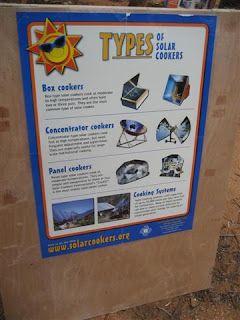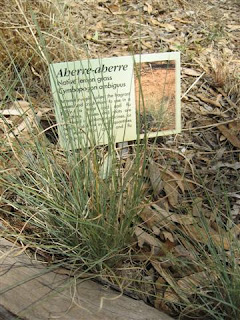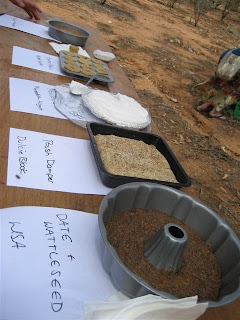.JPG) We've returned from our visit to Alice Springs and fingers crossed, we'll soon see some Transition Town action starting up there.
We've returned from our visit to Alice Springs and fingers crossed, we'll soon see some Transition Town action starting up there.Alice Springs is in the centre of Australia in desert country. The average rainfall, according to the Bureau of Meteorology is 286mm per year, but it is very unpredictable and variable, so growing food is challenging. They do rely on an underground water supply, but this seems to be slightly salty and doesn't seem to be being monitored on its usage.
.JPG) We had a few engagements while we were there - first up the Eco-Fair. ABOVE is a photo of a solar box cooker baking up some treats for the solar cook off challenge. You can see the type of country and how harsh it is.
We had a few engagements while we were there - first up the Eco-Fair. ABOVE is a photo of a solar box cooker baking up some treats for the solar cook off challenge. You can see the type of country and how harsh it is..JPG) ABOVE - a trailer full of good ideas - an aquaponics system (mixing fish and hydroponic growing), solar panel, wind generator, cacti, worm farms and wicking beds.
ABOVE - a trailer full of good ideas - an aquaponics system (mixing fish and hydroponic growing), solar panel, wind generator, cacti, worm farms and wicking beds..JPG)
BELOW - a poster about solar ovens and the various types you can buy or make.
.JPG) BELOW - information about food shopping and how to green it up and reduce food miles and carbon emissions.
BELOW - information about food shopping and how to green it up and reduce food miles and carbon emissions..JPG)
BELOW - the Fair was set in the Olive Pink Botanic Garden which has a wonderful display of bushtucker and useful desert plants including native crotolarias and other legumes.
.JPG)
.JPG)
BELOW - native lemon grass
.JPG)
BELOW - an interpretive sign so people can wander at their own pace and learn more about bushfood, Indigenous knowledge and what grows well there.
.JPG)
BELOW - where to find witchetty grubs for protein.
.JPG) BELOW - the gardens also had some lovely art and sculpture incorporated throughout
BELOW - the gardens also had some lovely art and sculpture incorporated throughout.JPG) BELOW - the entrants in the solar cook off challenge
BELOW - the entrants in the solar cook off challenge.JPG)
BELOW - a look around the Fair.
.JPG) BELOW - promoting cycling. Alice Springs is pretty much flat, so cycling is an option (not in the summer though - way too hot). Here visitors could book in for a free bike service and check up.
BELOW - promoting cycling. Alice Springs is pretty much flat, so cycling is an option (not in the summer though - way too hot). Here visitors could book in for a free bike service and check up.We also did a couple of Transition Town presentations - for business and council.
I'll post more information on their Solar City project and the successes they've had.
Cheers,
Sonya Wallace
.JPG)
.JPG)
.JPG)
.JPG)
.JPG)
No comments:
Post a Comment
Thank you for leaving your comments, it is appreciated. If commenting as 'anonymous' just leave your name so we know who you are, thanks.